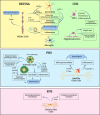Glial cell alterations in diabetes-induced neurodegeneration
- PMID: 38236305
- PMCID: PMC10796438
- DOI: 10.1007/s00018-023-05024-y
Glial cell alterations in diabetes-induced neurodegeneration
Abstract
Type 2 diabetes mellitus is a global epidemic that due to its increasing prevalence worldwide will likely become the most common debilitating health condition. Even if diabetes is primarily a metabolic disorder, it is now well established that key aspects of the pathogenesis of diabetes are associated with nervous system alterations, including deleterious chronic inflammation of neural tissues, referred here as neuroinflammation, along with different detrimental glial cell responses to stress conditions and neurodegenerative features. Moreover, diabetes resembles accelerated aging, further increasing the risk of developing age-linked neurodegenerative disorders. As such, the most common and disabling diabetic comorbidities, namely diabetic retinopathy, peripheral neuropathy, and cognitive decline, are intimately associated with neurodegeneration. As described in aging and other neurological disorders, glial cell alterations such as microglial, astrocyte, and Müller cell increased reactivity and dysfunctionality, myelin loss and Schwann cell alterations have been broadly described in diabetes in both human and animal models, where they are key contributors to chronic noxious inflammation of neural tissues within the PNS and CNS. In this review, we aim to describe in-depth the common and unique aspects underlying glial cell changes observed across the three main diabetic complications, with the goal of uncovering shared glial cells alterations and common pathological mechanisms that will enable the discovery of potential targets to limit neuroinflammation and prevent neurodegeneration in all three diabetic complications. Diabetes and its complications are already a public health concern due to its rapidly increasing incidence, and thus its health and economic impact. Hence, understanding the key role that glial cells play in the pathogenesis underlying peripheral neuropathy, retinopathy, and cognitive decline in diabetes will provide us with novel therapeutic approaches to tackle diabetic-associated neurodegeneration.
Keywords: Astrocytes; Cognitive decline; Diabetes; Diabetic neuropathy; Diabetic retinopathy; Glial cells; Microglia; Muller; Neurodegeneration; Schwann cells.
© 2024. The Author(s).
Conflict of interest statement
The authors report no competing interests.
Figures


Similar articles
-
Role of Inflammation in Diabetic Retinopathy.Int J Mol Sci. 2018 Mar 22;19(4):942. doi: 10.3390/ijms19040942. Int J Mol Sci. 2018. PMID: 29565290 Free PMC article. Review.
-
Targeted pharmacotherapy against neurodegeneration and neuroinflammation in early diabetic retinopathy.Neuropharmacology. 2021 Apr 1;187:108498. doi: 10.1016/j.neuropharm.2021.108498. Epub 2021 Feb 12. Neuropharmacology. 2021. PMID: 33582150 Review.
-
Diabetes-Related Neurological Implications and Pharmacogenomics.Curr Pharm Des. 2018;24(15):1695-1710. doi: 10.2174/1381612823666170317165350. Curr Pharm Des. 2018. PMID: 28322157 Review.
-
The Effects of Modified Curcumin Preparations on Glial Morphology in Aging and Neuroinflammation.Neurochem Res. 2022 Apr;47(4):813-824. doi: 10.1007/s11064-021-03499-4. Epub 2022 Jan 6. Neurochem Res. 2022. PMID: 34988899 Review.
-
Bioengineered 3D Glial Cell Culture Systems and Applications for Neurodegeneration and Neuroinflammation.SLAS Discov. 2017 Jun;22(5):583-601. doi: 10.1177/2472555217691450. Epub 2017 Feb 21. SLAS Discov. 2017. PMID: 28346104 Review.
Cited by
-
Regulatory T cell expansion prevents retinal degeneration in type 2 diabetes.J Neuroinflammation. 2024 Dec 23;21(1):328. doi: 10.1186/s12974-024-03323-0. J Neuroinflammation. 2024. PMID: 39716335 Free PMC article.
-
High Rosmarinic Acid Content Melissa officinalis L. Phytocomplex Modulates Microglia Neuroinflammation Induced by High Glucose.Antioxidants (Basel). 2025 Jan 29;14(2):161. doi: 10.3390/antiox14020161. Antioxidants (Basel). 2025. PMID: 40002348 Free PMC article.
-
Effects of Cholesterol Metabolism on Corneal Endothelial Dysfunction in Patients With Type 1 Diabetes.Invest Ophthalmol Vis Sci. 2025 Aug 1;66(11):9. doi: 10.1167/iovs.66.11.9. Invest Ophthalmol Vis Sci. 2025. PMID: 40762538 Free PMC article.
-
Retinal Inflammation and Reactive Müller Cells: Neurotrophins' Release and Neuroprotective Strategies.Biology (Basel). 2024 Dec 9;13(12):1030. doi: 10.3390/biology13121030. Biology (Basel). 2024. PMID: 39765697 Free PMC article. Review.
-
The Calcium Signalling Profile of the Inner Blood-Retinal Barrier in Diabetic Retinopathy.Cells. 2025 Jun 6;14(12):856. doi: 10.3390/cells14120856. Cells. 2025. PMID: 40558483 Free PMC article. Review.
References
-
- Collaborators G 2019 B and VI, Adelson JD, Bourne RRA, et al. Causes of blindness and vision impairment in 2020 and trends over 30 years, and prevalence of avoidable blindness in relation to VISION 2020: the Right to Sight: an analysis for the Global Burden of Disease Study. Lancet Global Heal. 2021;9(2):e144-e160. 10.1016/s2214-109x(20)30489-7. - PMC - PubMed
Publication types
MeSH terms
Grants and funding
LinkOut - more resources
Full Text Sources
Medical
Research Materials

